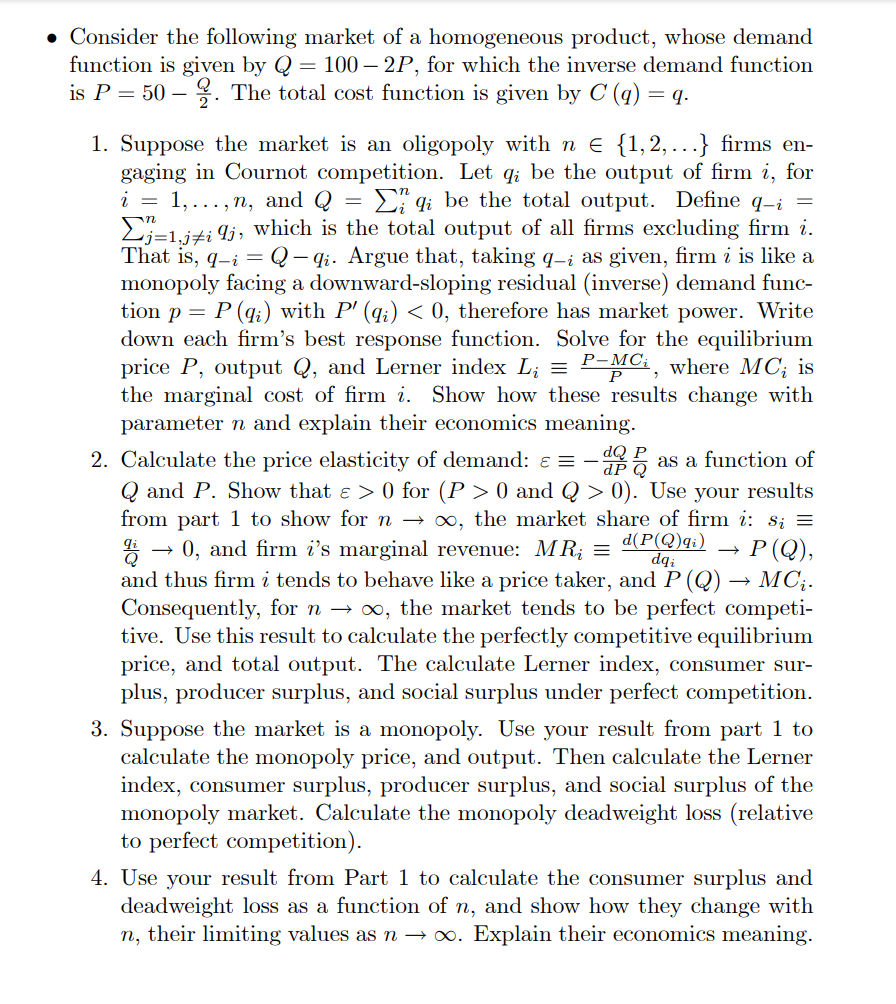
Consider the following market of a homogeneous product, whose demand function is given by Q 100 2P, for which the inverse demand function is P = 50 -... The total cost function is given by C(q) = q. tion p = 1. Suppose the market is an oligopoly with n E {1, 2,...} firms en- gaging in Cournot competition. Let qi be the output of firm i, for i = 1, ...,n, and Q qi be the total output. Define q-i = {j=1,1+i 9;, which is the total output of all firms excluding firm i. That is, q-i = Q-qi. Argue that, taking q-i as given, firm i is like a monopoly facing a downward-sloping residual (inverse) demand func- P(qi) with P' (qi) 0 for (P >0 and Q > 0). Use your results from part 1 to show for n , the market share of firm i: si = 0, and firm is marginal revenue: MR; = d(P(Q)qi) P(Q), and thus firm i tends to behave like a price taker, and P (Q) MC;. Consequently, for n 00, the market tends to be perfect competi- tive. Use this result to calculate the perfectly competitive equilibrium price, and total output. The calculate Lerner index, consumer sur- plus, producer surplus, and social surplus under perfect competition. 3. Suppose the market is a monopoly. Use your result from part 1 to calculate the monopoly price, and output. Then calculate the Lerner index, consumer surplus, producer surplus, and social surplus of the monopoly market. Calculate the monopoly deadweight loss (relative to perfect competition). 4. Use your result from Part 1 to calculate the consumer surplus and deadweight loss as a function of n, and show how they change with n, their limiting values as n +0. Explain their economics meaning. dqi Consider the following market of a homogeneous product, whose demand function is given by Q 100 2P, for which the inverse demand function is P = 50 -... The total cost function is given by C(q) = q. tion p = 1. Suppose the market is an oligopoly with n E {1, 2,...} firms en- gaging in Cournot competition. Let qi be the output of firm i, for i = 1, ...,n, and Q qi be the total output. Define q-i = {j=1,1+i 9;, which is the total output of all firms excluding firm i. That is, q-i = Q-qi. Argue that, taking q-i as given, firm i is like a monopoly facing a downward-sloping residual (inverse) demand func- P(qi) with P' (qi) 0 for (P >0 and Q > 0). Use your results from part 1 to show for n , the market share of firm i: si = 0, and firm is marginal revenue: MR; = d(P(Q)qi) P(Q), and thus firm i tends to behave like a price taker, and P (Q) MC;. Consequently, for n 00, the market tends to be perfect competi- tive. Use this result to calculate the perfectly competitive equilibrium price, and total output. The calculate Lerner index, consumer sur- plus, producer surplus, and social surplus under perfect competition. 3. Suppose the market is a monopoly. Use your result from part 1 to calculate the monopoly price, and output. Then calculate the Lerner index, consumer surplus, producer surplus, and social surplus of the monopoly market. Calculate the monopoly deadweight loss (relative to perfect competition). 4. Use your result from Part 1 to calculate the consumer surplus and deadweight loss as a function of n, and show how they change with n, their limiting values as n +0. Explain their economics meaning. dqi







